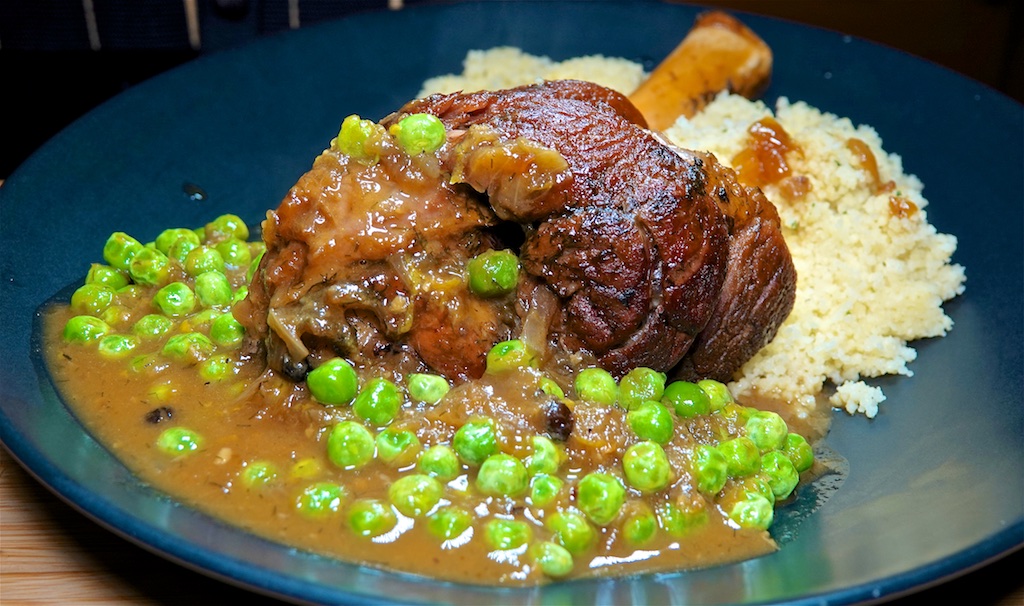Lamb shanks come from the lower part of a lamb leg. These ones from Keller Crafted are hind leg shanks, and you’ll see smaller shanks from the front leg. They contain working muscles and connective tissue, so a long and slow cooking method is needed to bring out their best.
Lamb shanks then are perfect for an autumn or winter braise! You want the meat to be tender and falling off the bone, so these were braised in a moderate oven for 3 hours. But if you’ve got an Instant Pot or pressure cooker, you can get the same results in just 45 mins! I’ve also seen slow cooker recipes that cook shanks for 8 hours.
Juniper has a piney flavor that reminds me of rosemary — it’s the main flavor of London dry gin. Juniper berries are a great flavor match for lamb, but they can be hard to find in regular supermarkets. (I got mine from Amazon.)
This is actually my mom’s recipe — in our family we call it “lamb shanks to die for” — so I’ve been enjoying this for years!
Ingredients
- 2 lamb shanks
- 1 onion, chopped
- 4 cloves garlic, minced
- 2 cups chicken stock or bone broth
- 12 juniper berries
- 2 teaspoons dried dill
- 1 cup frozen peas
- 2 tablespoons lemon juice
- zest of 1 lemon
Instructions
Preheat the oven to 350°F while you chop the onion and mince the garlic.
Heat a Dutch oven to medium high on the stove stop — the Dutch oven needs to be large enough to hold the shanks in a single layer. Brown the shanks on all sides, then remove them to a plate.
Lower the heat to medium then add the onion and some salt to help draw out the liquid. (As they cook they’ll dissolve the brown “fond” the shanks left in the bottom of the pot.)
When the onions are translucent, add the garlic and fry briefly. Then add the stock, dill and juniper berries. (If possible, crush each juniper berry with your fingers to help release their flavor.) Then add the lamb shanks to the liquid.
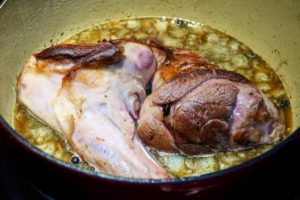
Raise the heat to high and bring to a boil, then cover and move the pot to the oven.
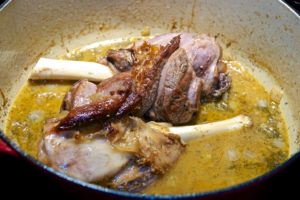
Every hour baste the shanks with the cooking liquid. And add more water if the pot is drying out.
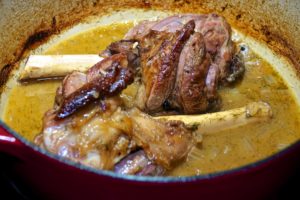
After 3 hours, put the pot on the stove over a medium heat and remove the lamb shanks. You’ll need a large spoon to help with this because the meat will threaten to fall off the bone! (When I do these in a pressure cooker, I put the sauce over a high heat and boil for some time to reduce the liquid.)
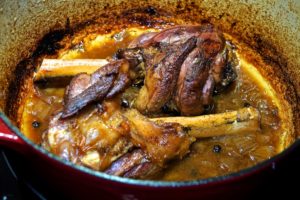
Add the lemon juice and lemon zest, season with salt and pepper, then add the peas. Cook briefly until the peas are bright green. Then spoon the sauce over the shanks.
Tasting Notes
The lamb shanks were incredibly tender with chunks of meat easily separating out. The flavor is deep and clean rather than gamey, with an unctuous mouth feel (thanks to all that connective tissue having broken down into gelatin). The acidic hit of lemon helps lighten the sauce, and the sweetness of the peas is a nice contrast to the lemon.
These are large lamb shanks, so you could strip chunks of meat off the bone and get two serves from each shank. Or use one shank per plate for the full bone-in experience, and you’ll probably have leftovers (lamb sandwiches or rolls are always a treat).
